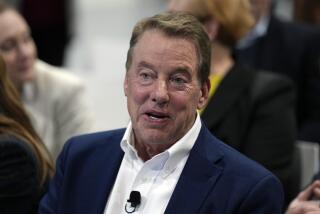How Alan Mulally rescued Ford
Some people underestimate Alan Mulally when they first meet him. Ford Motor Co.’s 66-year-old chief executive, who grew up in Kansas and once aspired to be an astronaut, looks and sometimes acts like an overgrown Boy Scout. He laces his speech with words such as “neat,” “cool” and “absolutely.”
But the farm-boy exterior conceals one of business’ toughest, most ruthless managers. When a desperate Bill Ford recruited Mulally from Boeing in 2006, Ford was heading for a $12.7-billion loss and on the verge of losing its No. 2 sales spot in the U.S. to Toyota because of poor management and an uninspiring vehicle lineup.
Four years later, Ford reported a $6.6-billion profit — the biggest in the sector that year — and Toyota was comparing its cars with Fords, not Hondas, in its ads.
In his new book “American Icon: Alan Mulally and the Fight to Save Ford Motor Company,” author Bryce G. Hoffman, a veteran reporter with the Detroit News, details “one of the greatest turnarounds in business history” and, to a lesser extent, the man behind it.
Published by Crown Business, the book makes for a fascinating read for anyone who follows the car industry; others may find the story engaging too, if hard work in places.
Ford was in deep trouble in 2006, with a poisonous culture in which executives fought turf wars and sat through endless meetings but made the real decisions elsewhere.
When Mulally arrived, many of its senior managers in Dearborn, Mich., did not deign to drive Fords or even cars made by its rivals, preferring the Jaguars and Land Rovers made by its loss-making British luxury brands. The new boss made them drive Volkswagens and Hondas.
Importing a practice from Boeing, he introduced weekly meetings that were mandatory for all senior managers. Executives were barred from using BlackBerrys or belittling one another; they were required to grade their own progress on targets truthfully and to confront problems head-on.
Initially, Mulally faced resistance in a company — indeed, an industry — that has always viewed outsiders with suspicion.
But he made a series of canny decisions and astute appointments that protected Ford as the U.S. car industry headed into a crisis in 2008 that nearly sank the century-old company and its two Detroit competitors, General Motors and Chrysler.
Mulally protected product spending even as Ford cut thousands of staff and economized on everything else, down to paper clips and plant watering.
He made tough decisions only a cold-eyed non-car enthusiast would, such as selling Ford’s European premium brands and its stake in Mazda so it could focus on its core “blue oval” mass-market cars.
Some of the masterstrokes attributed to Mulally were already underway when he joined. His predecessors had begun steps to borrow $23.6 billion in 2006, just before credit markets closed.
But Mulally sealed that deal — brilliant in hindsight because it enabled Ford to refuse a federal bailout and a trip through bankruptcy that would have seen its shareholding family’s members diluted out of their birthright.
Avoiding Chapter 11 bankruptcy also gave Ford’s cars an edge over GM and Chrysler with U.S. consumers, while better vehicles developed on Mulally’s watch began rolling into dealerships.
Some of the stories in the book have been told before, but the author delivers much new, excellent reporting collected in interviews with all the main people concerned.
Mulally is a constantly chipper, boosterish presence, whether bucking up dispirited colleagues, preparing for a presentation in Congress or hugging a dumbfounded customer at a dealership in Shanghai.
“Mulally ripped off the bandage, cauterized the wound and cured the disease,” the author concludes, with his typical gusto. “Only an outsider could do that.”
Reed is the motor industry correspondent for the Financial Times of London, in which this review first appeared.
More to Read
Inside the business of entertainment
The Wide Shot brings you news, analysis and insights on everything from streaming wars to production — and what it all means for the future.
You may occasionally receive promotional content from the Los Angeles Times.










